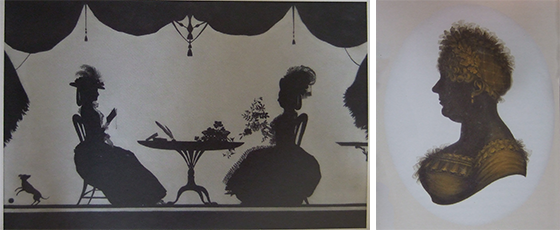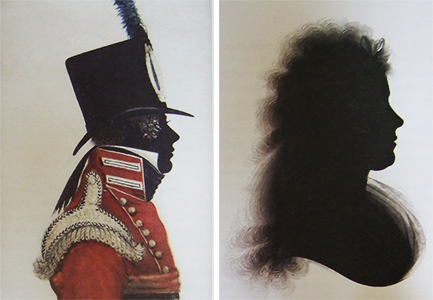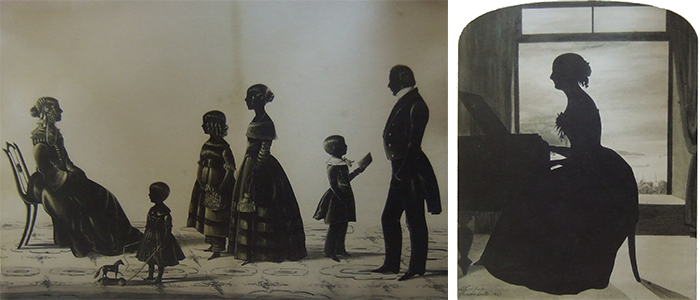Silhouette methods - painted on paper or card
Most popular between 1760 and 1860, these forms of silhouettes often appear closest to portrait miniatures. They tend to have softer lines and richer details than cut pieces. However, they rely on a slower and more difficult technique, which some early artists found almost impossible to master.

Silhouette artists who painted on paper or card tended to do so as one part of an artistic career; Francis Torond (c 1743-1812), one of the earliest to paint on paper, was a multi-talented artist who established his Oxford Street Drawing Academy in 1776. An example of Torond's work is shown in the image above and left. Generally, painted silhouettes require an artist with some ability, not one who was wholly reliant upon a machine to do the work. The talent required is evident in the work by John Field illustrated above and to the right. The number of silhouette artists who painted their work declined throughout the 19th century, and today the number of painters is far fewer than cutters.
Historically, painting materials included Indian ink, gouache, watercolour and even beer and soot. In the 19th century ‘bronzing’ was a common embellishment, pioneered by John Field. Artists used a variety of materials to achieve these golden highlights including very fine gold leaf, gold paint, yellow ochre and deep cadmium. The bronzing process and the fine level of finish that could be achieved, is shown in the three images directly below.

In the same way as cutters, painters would begin with a sketched outline, though this was far more likely to have been drawn by hand than machine. The outline was often drawn on a rough sheet, and then traced or rubbed on to a finer piece of card or paper for painting. The stages of painting a silhouette portrait are shown in the three pictures immediately below.

 The painter might use a variety of colours, shades and materials to complete their profile. The main body of a customer's portrait might be colourful, particularly, when detailing military costume, often though it was achieved simply with shades of grey. Details of the silhouette such as hair, feathers or lace could be added with layers of thinned coloured paint, built up over many applications. Backgrounds were generally painted in watercolour paint, of various shades and depths. These different approaches are illustrated in the images to the left and below. However, it should be remembered that the face was, and is always, in black.
The painter might use a variety of colours, shades and materials to complete their profile. The main body of a customer's portrait might be colourful, particularly, when detailing military costume, often though it was achieved simply with shades of grey. Details of the silhouette such as hair, feathers or lace could be added with layers of thinned coloured paint, built up over many applications. Backgrounds were generally painted in watercolour paint, of various shades and depths. These different approaches are illustrated in the images to the left and below. However, it should be remembered that the face was, and is always, in black.

Gum Arabic was a typical finishing touch, washed on the surface of painted silhouettes to give a shiny, protective finish.
